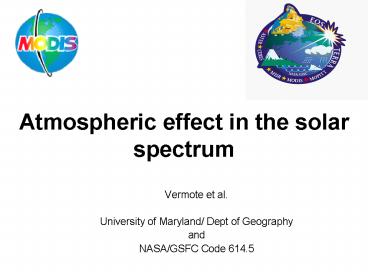Atmospheric effect in the solar spectrum - PowerPoint PPT Presentation
1 / 48
Title:
Atmospheric effect in the solar spectrum
Description:
Solution of the Radiative Transfer in the reflective domain for non ... noon at 45degree latitude at vernal equinox looking straight up at 0.45 m, 0.55 m, 0.65 ... – PowerPoint PPT presentation
Number of Views:73
Avg rating:3.0/5.0
Title: Atmospheric effect in the solar spectrum
1
Atmospheric effect in the solar spectrum
- Vermote et al.
- University of Maryland/ Dept of Geography
- and
- NASA/GSFC Code 614.5
2
Solar Energy Paths
3
atmospheric contribution
direct direct
diffuse direct
direct diffuse
multiple scattering
4
Solar (reflective) spectral domain
5
Observation Geometry
Solar zenith angle
View zenith angle
Relative azimuth angle
6
Solution of the Radiative Transfer in the
reflective domain for non absorbing atmosphere
and lambertian ground
Ground reflectance ( albedo for lambertian)
Atmospheric reflectance
Atmospheric Transmissions
Apparent reflectance at satellite level
Atmosphere spherical albedo
7
Perfect Lambertian Reflector
Radiance of the Perfect Lambertian Reflector
Es
Isotropic radiation
8
Simple Radiative Transfer Equation
9
SRTE (cont.)
Absorbing ground
10
SRTE (cont.)
Ei
Et
11
SRTE (cont.)
12
SRTE (cont.)
?
v
E0
Er
40
13
SRTE 1 interaction (cont.)
14
SRTE 2 interactions
15
SRTE Multiple Interactions
?groundSatm lt 1 so when n-gt8 then (?groundSatm)n
-gt0 Therefore
16
STRE for non absorbing atmosphere and lambertian
ground
Ground reflectance ( albedo for lambertian)
Atmospheric reflectance
Atmospheric Transmissions
Apparent reflectance at satellite level
Atmosphere spherical albedo
17
The composition of the atmosphere
18
Gaseous Absorption (H2O)
19
Modified SRTE to account for absorption
In case of a pure molecular atmosphere (no
aerosol) we can write
m is the air mass 1/cos(?s)1/ cos(?v) Ugaz is
the gaz concentration
10
20
Final SRTE approximation
21
Water vapor effect for different sensors in the
near infrared
22
Scattering angle ,
- The scattering angle, ??? is the relative angle
between the incident and the scattered radiation
Incident Radiation
Particle
?
scattered radiation
23
Phase function
- The phase function, P(?)?? describe the
distribution of scattered radiation for one or an
set of particles. It is normalized such as
since
we have
24
Rayleigh/molecular scattering 1/4
- Rayleigh or molecular scattering refers to
scattering by atmospheric gases, in that case
25
Rayleigh/molecular scattering 2/4
- The concentration in scatterer is better
described by the efficiency they scatter at a
certain wavelength or the proportion of direct
transmission which is related to the spectral
optical thickness ????
E0(??
Et(?)/ E0(?)e- ????
Et(??
- For Rayleigh ?????is proportional to ?-4 and for
standart pressure is 0.235 at 0.45 ?m
26
Rayleigh/molecular scattering 3/4
- The rayleigh reflectance, ?R, could be crudely
approximated by
27
Rayleigh/molecular scattering 4/4
- Compute the reflectance of the sky (assumed clear
no aerosol) at solar noon at 45degree latitude at
vernal equinox looking straight up at 0.45?m,
0.55?m, 0.65?m
28
Aerosol scattering 1/5
- aerosol scattering refers to scattering by
particles in suspension in the atmosphere (not
molecules). The MIE scattering theory could be
applied to compute the aerosol phase function and
spectral optical depth, based on size
distribution, real and imaginary index.
29
Aerosol scattering 2/5
Continental aerosol phase function
30
Aerosol scattering 3/5
single scattering albedo (0.2-1.0) to account for
absorbing particles
31
Aerosol scattering 4/5
Continental aerosol optical thickness spectral
variation
60
32
Aerosol scattering 5/5
Continental aerosol single scattering albedo
spectral variation
33
Atmospheric effect Vegetation 1/3
34
Atmospheric effect Vegetation 2/3
No absorption, Continental aerosol
35
Atmospheric effect Vegetation 3/3
Absorption tropical atmosphere, Continental
aerosol
36
Atmospheric effect Ocean 1/2
37
Atmospheric effect Ocean 2/2
38
Perfect Lambertian Reflector
Isotropic radiation
39
Different Types of Reflectors
diffuse reflector (lambertian)
Specular reflector (mirror)
Nearly Specular reflector (water)
nearly diffuse reflector
40
Sun glint as seen by MODIS
Gray level temperature image
41
MODIS data illustrating the hot-spot over dense
vegetation
42
BRDF atmosphere coupling correction
Lambertian infinite target approximation
BDRF atmosphere coupling approximation
43
Adjacency effect correction
Lambertian infinite target approximation
adjacency effect approximation
44
Adjacency effect correction (practical
implementation)
45
Adjacency effect correction (testing)
46
Adjacency effect correction (testing)
Reflectances observed over a horizontal transect
on the checkerboard. The red bars are the true
surface reflectance, the blue bars correspond to
the top of the atmosphere signal including
adjacency effect. The green bars correspond to
the corrected data using the infinite target
assumption. The open square correspond to the
data corrected for the adjacency effect using the
operational method developed.
47
Adjacency effect correction (validation)
48
Conclusions
- Review of atmospheric effect including the
BRDF-coupling and the adjacency effect - Current version of MOD09 (Collection 4) does not
include the BRDF-coupling or adjacency effect
correction - Collection 5 (start scheduled in Jan06), will
include adjacency correction for 250m bands.
BRDF-coupling correction is still being evaluated.































